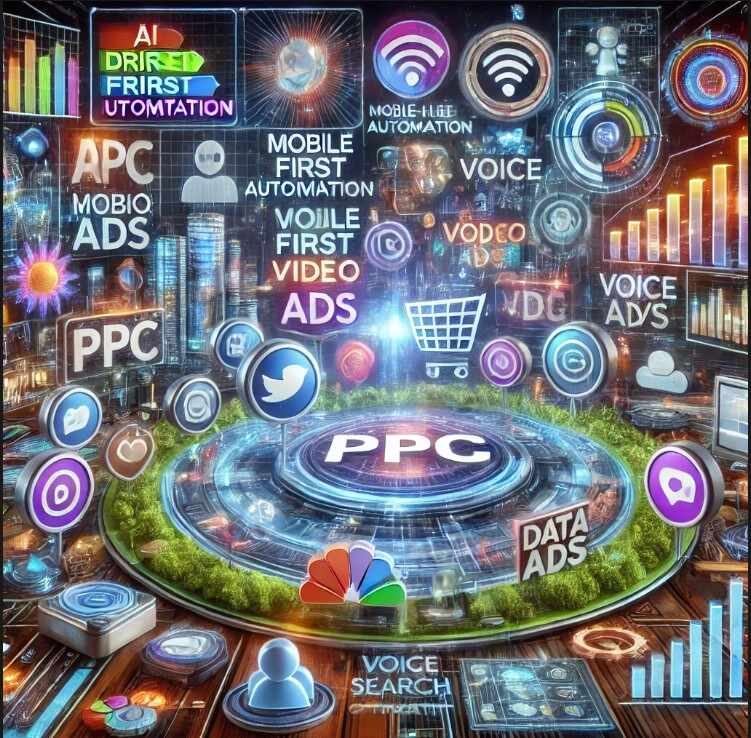Top 19 PPC Trends You Need to Follow in 2024
Published on September 10, 2024

Top 19 PPC Trends You Need to Follow in 2024
Introduction
In the fast-evolving digital marketing world, staying ahead of Pay-Per-Click (PPC) trends is key to optimizing ad spend and achieving measurable results. For businesses and advertisers using platforms like Google Ads, Microsoft Ads, Spotify Ads, and Hulu Ads, the landscape is filled with new opportunities to connect with audiences in more effective, personalized ways.
PPC, a model in which advertisers pay each time their ad is clicked, remains central to digital advertising strategies. With advancements like AI-driven automation, enhanced targeting options, and the rise of video and voice ads, it’s essential to adapt to the latest trends to stay competitive. Here’s a look at the 19 PPC trends that will shape 2024.
1. Increased Focus on AI and Automation
AI is revolutionizing PPC, helping advertisers streamline campaigns and maximize ROI. Tools like Google Ads Performance Max (PMax), SA360, and digital ad intelligence platforms optimize bidding and targeting across channels. AI-driven ad intelligence ensures marketers can focus on strategy while AI handles the mechanics, like generating ad copy, headline ideas, and campaign performance insights.
2. Enhanced Audience Targeting
Audience segmentation continues to improve with tools that gather detailed demographic data. Platforms like Google Ads, Microsoft Ads, and Amazon offer advanced targeting options, helping advertisers reach audiences more precisely. The trend towards hyper-localized ads, seen with Google Local Inventory Ads, enhances targeting by focusing on specific locations, improving engagement rates.
3. Video Ads on the Rise
Video advertising is booming on platforms like YouTube, Spotify, and Tubi. Video ads are especially popular with younger audiences, and platforms like Hulu and Netflix are expected to enhance ad placement opportunities. As ad-supported streaming becomes more popular, video ads help brands capture audience attention in dynamic ways.
4. Voice Search Optimization
As more people use voice assistants, optimizing PPC for voice search is essential. Keywords should reflect natural language phrases, especially for local service ads and Google Local Service Ads.
5. Mobile-First Advertising
With mobile usage surpassing desktop, mobile-first advertising is critical. Google Ads' mobile-friendly ad formats, like responsive search ads, enhance user experience and conversion rates on mobile devices. For apps, Apple Search Ads and Google UAC are increasingly important in 2024.
6. Shopping Ads Evolution
Shopping Ads are evolving with advanced features like dynamic product recommendations, available on platforms like Google Shopping and Amazon. Performance Max ads streamline shopping ads management, helping e-commerce brands improve conversion rates by focusing on high-intent users.
7. Sustainability and Ethical Advertising
With the rise of sustainability and ethical advertising, consumers gravitate towards brands that align with their values. Incorporating this theme into ad campaigns can help brands establish trust, especially on platforms like Google Ads where ad copy can emphasize sustainable practices.
8. Integration of Social Media Advertising
Social Media remains a key PPC component. Platforms like Instagram, TikTok, and Snapchat now offer robust PPC options, with Quora Ads gaining traction for B2B marketers. Advertisers using cross-platform strategies can reach wider audiences with consistent messaging.
9. Use of Augmented Reality (AR)
AR ads are on the rise, with platforms like Snapchat and Facebook pioneering AR tools that allow users to interact with products. AR ads offer an immersive experience, enabling customers to “try” products virtually.
10. Data Privacy and Compliance
With regulations like GDPR and CCPA, data privacy remains a top priority. Tools like ad intelligence software help marketers ensure compliance while optimizing campaign effectiveness. Using first-party data rather than third-party cookies is essential for privacy and performance.
11. The Importance of Localized Ads
Localized ads targeting specific regions have higher engagement rates. Local Inventory Ads and Location Ads allow advertisers to target customers based on their geographic location, ideal for driving in-store traffic and building local brand recognition.
12. Retargeting Strategies
Retargeting remains a valuable tactic. Using PPC tools like Google’s remarketing lists, advertisers can target users who previously interacted with their brand, driving them further along the conversion funnel.
13. Cross-Platform Campaigns
Advertising across multiple platforms has proven effective for brand consistency. Cross-platform PPC management tools help streamline campaign performance on platforms like Google Ads, Facebook Ads, and Amazon Advertising, giving advertisers a 360-degree Approach to PPC.
14. Interactive Ad Formats
Interactive ads such as polls, swipeable ads, and quizzes increase engagement by allowing users to participate. Spotify Ads and Facebook Stories offer interactive ad options that can elevate brand recall and engagement.
15. Real-Time Analytics and Insights
With real-time PPC analytics tools, advertisers can adjust campaigns based on up-to-the-minute data. Platforms like Search Ads 360 and Google Analytics provide real-time data, allowing for immediate campaign optimizations.
16. Dynamic Ad Customization
Dynamic ads adapt based on user behavior. These ads, available on Facebook and Google, personalize content for each user, making them especially effective in sectors like retail and travel.
17. Integration with Influencer Marketing
PPC and influencer marketing often intersect, especially on platforms like Instagram and YouTube. Partnering with influencers can amplify reach and credibility for campaigns, creating a more authentic customer experience.
18. Leveraging First-Party Data
First-party data is essential for effective PPC targeting, especially with changes in data privacy regulations. Leveraging data from sources like Google Ads and Facebook helps optimize campaigns while maintaining compliance.
19. AI-Driven Ad Copy and Creative Optimization
AI now plays a significant role in ad copy and creative optimization. Tools like Google Ads AI-powered Smart Campaigns use machine learning to craft effective ads based on performance data, taking much of the guesswork out of PPC.
